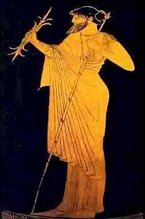
Today, I was cleaning a lot of thirteen rag-tag mixed coins I had bought over a year ago. One of the vendors had offered the coins at $1.75 as I recall. About 30 minutes into cleaning the heavily crusted coins I saw nothing that presented any real promise with the exception of three Seleucids I was focusing on.
There was one coin, very thick, that appeared to be nothing but “concrete” and no promise. I “bambooed” it a bit and was about to put it aside as a lost cause when I decided to stick it back in the soup. I continued to check the other coins with no particular interest in the coin I speak of. Eventually, I did go back to the coin and saw what I thought were definite heavy fissures with large lumps on top of the fissures.
I dug around with my bamboo skewer and all at once one of the lumps gave way and I saw bronze. I placed the coin back in the solution and continued to work on the other coins. After and hour or so, I pulled the coin again and the lumps began to break away as I continued to bamboo the coin. Then I saw what I thought was an eagle’s wing and suddenly my cleaning focus was on the eagle coin.
I continued to probe with my bamboo skewer as I zapped at max power. Very slowly with much power and probing, I was able to excavate a coin I almost tossed aside! I am posting the coin above so you can see the dividends yielded by my perseverance. I think there is a lesson here for us all. Be sure and zap everything you receive in a lot! One simply never knows what lies beneath a heavily encrusted coin. That is one reason I enjoy crusties so much. I have not attributed the coin yet, but I am looking forward to seeing what kind of Greek coin I have excavated! You will observe the patina is quite bright, but that is the result and nature of working with such a heavily encrusted coin. God Bless.. Jerry..
There was one coin, very thick, that appeared to be nothing but “concrete” and no promise. I “bambooed” it a bit and was about to put it aside as a lost cause when I decided to stick it back in the soup. I continued to check the other coins with no particular interest in the coin I speak of. Eventually, I did go back to the coin and saw what I thought were definite heavy fissures with large lumps on top of the fissures.
I dug around with my bamboo skewer and all at once one of the lumps gave way and I saw bronze. I placed the coin back in the solution and continued to work on the other coins. After and hour or so, I pulled the coin again and the lumps began to break away as I continued to bamboo the coin. Then I saw what I thought was an eagle’s wing and suddenly my cleaning focus was on the eagle coin.
I continued to probe with my bamboo skewer as I zapped at max power. Very slowly with much power and probing, I was able to excavate a coin I almost tossed aside! I am posting the coin above so you can see the dividends yielded by my perseverance. I think there is a lesson here for us all. Be sure and zap everything you receive in a lot! One simply never knows what lies beneath a heavily encrusted coin. That is one reason I enjoy crusties so much. I have not attributed the coin yet, but I am looking forward to seeing what kind of Greek coin I have excavated! You will observe the patina is quite bright, but that is the result and nature of working with such a heavily encrusted coin. God Bless.. Jerry..

1 comment:
That eagle looks Ptolemaic to me, or just maybe Tyrian. I've seen a few Seleukids with eagles very similar to that, but usually if you see an eagle in that style, it's Ptolemaic-- though some of the Lebanese/Phoenican coins have eagles nearly identical in design to those of the Ptolemies.
Post a Comment